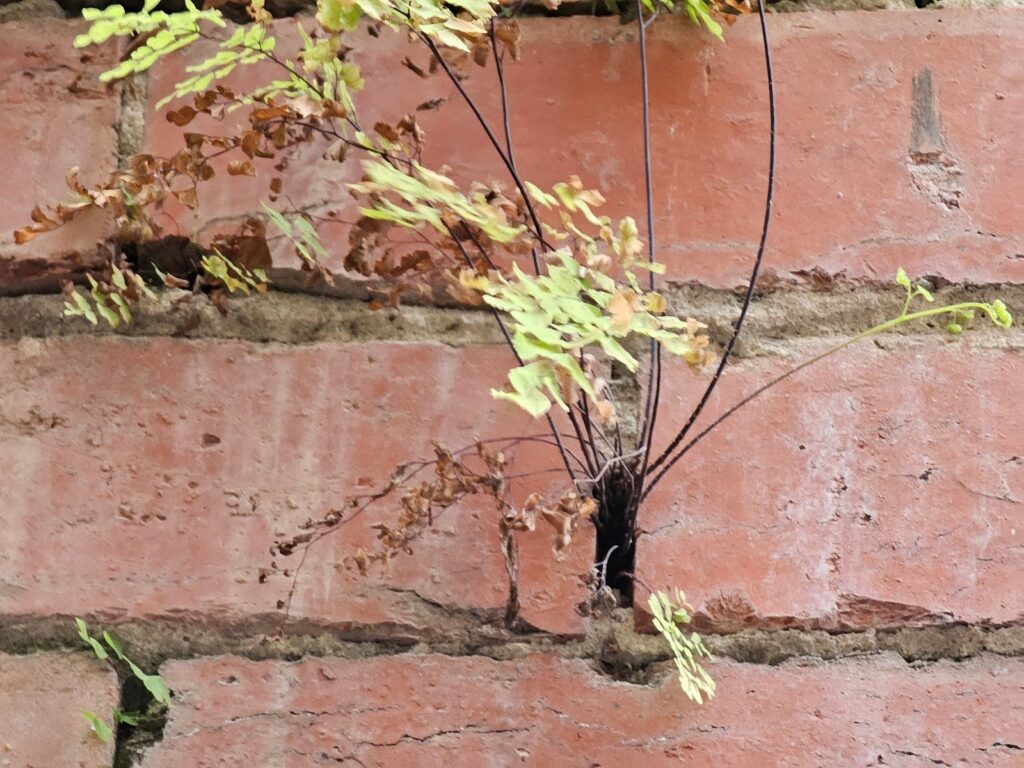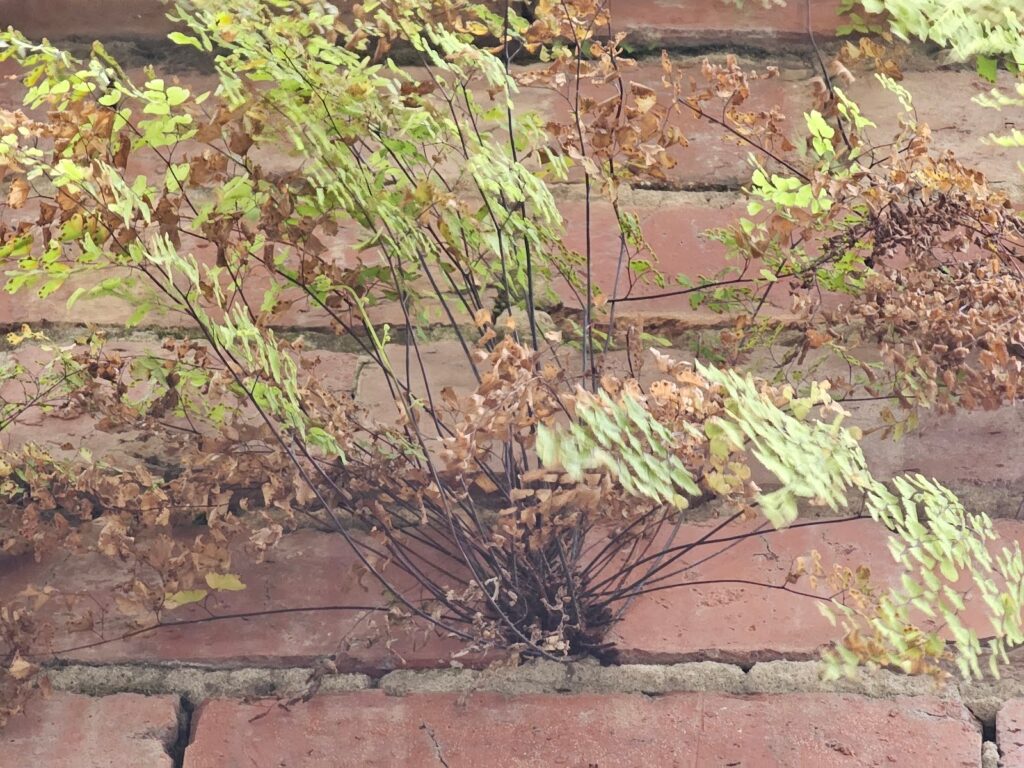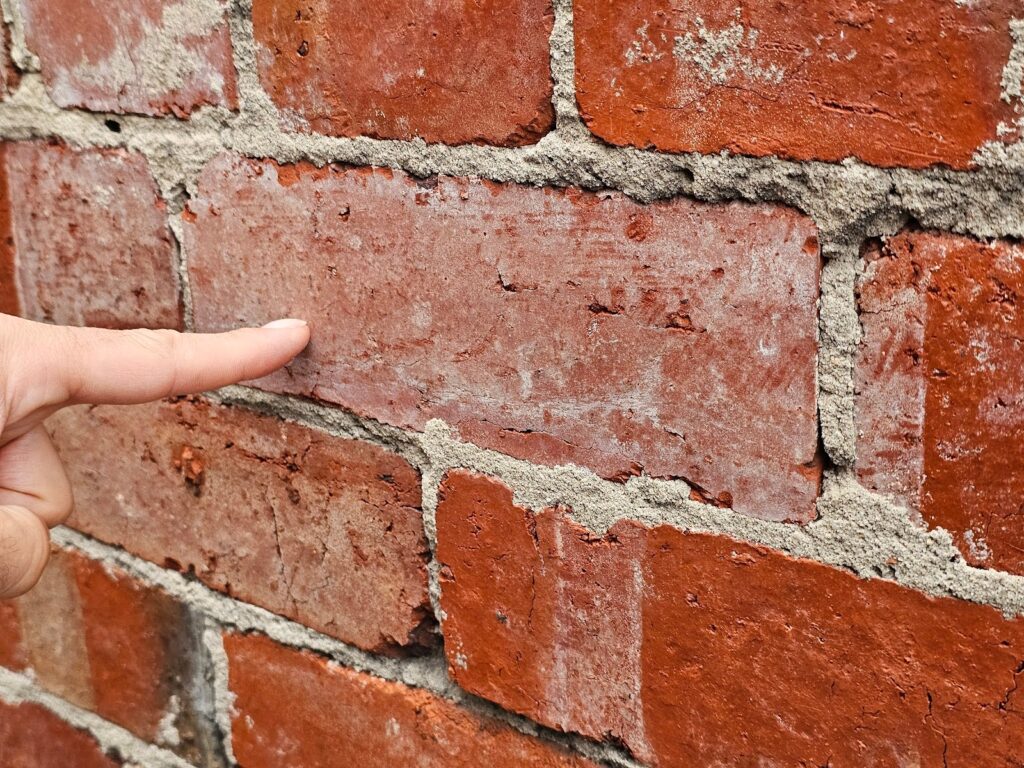Controlling Plants Growing in Brickwork: Effective Solutions (Part II)
This past week, we started looking at a building with a rough exterior brick facade at the side of the building. The brick wall originally wasn’t intended to be exposed but the adjacent building had been since demolished. After demolition of the adjacent building, the remaining side of the building had not been repointed or refurbished to fully function as an exterior wall and mortar joints continue to deteriorate and plants started growing right out of the mortar joints.
Here, in the next photo, we show a deteriorated perpend joint in an opening directly between two bricks where the plant has a perfectly protected ledge to take root and grow. As this plant grows through the masonry, it causes damage to the adjacent areas of the brickwork. The small root systems grow into the joint, and all parts of the deteriorated mortar and parts where the brickwork has voids and or omissions.
Those roots create plan to breed that has a texture a bit like a sponge. That plant creates additional debris that gets caught in mortar joints and exacerbates moisture driven deterioration. This organic material in the joint is absorptive and causes heightened residual moisture accumulation and slower deters proper drying.
If you’re a DIY enthusiast or a homeowner looking for more information, you might just go to the internet and search the web for more information on masonry restoration and handling problem areas and issues such as the ones shown here in these photographs. As most of us are aware, nowadays, the internet can be both a curse and a blessing. It can bring tons of information right to our fingertips where we can learn a lot about the help we need to solve our problems, but not all of that information is accurate.
A client recently brought up some of these nuances and asked us about things they found on the web related to liquid applications that can be applied to the face of brick masonry to preserve and seal the outside of the face of brickwork. Here in Washington DC though we actually recommend against application of liquid applied sealers, in most cases, but this is a particularly nuanced subject because it depends on the particular type of substrate.
 Plants will invariably exacerbate the processes of masonry and brickwork deterioration, in several ways. The plant roots will pry apart the delicate materials of aged historic mortar joints. They therein create pathways for water to penetrate deeper into the structure.
Plants will invariably exacerbate the processes of masonry and brickwork deterioration, in several ways. The plant roots will pry apart the delicate materials of aged historic mortar joints. They therein create pathways for water to penetrate deeper into the structure.
Plants and plant growth will also trap moisture, preventing it from evaporating. This prolonged exposure to moisture will accelerate the rate of weathering and masonry deterioration. In the picture below, you can clearly see two different types of plant debris or matter, you can see the green leafs of the plant, in this case a fern, but you can also see the brown dead branches and leaf-like material. That leaf-like material will absorb water very easily. In this particular state, at the time of the photograph, the dead ferns were dry. Unlike the live leaves though, they change State more drastically when exposed to moisture such as typical rainfall. The cycle that residually repeats in this scenario is problematic.
These plant-based materials work a bit like a cotton ball where they will absorb water and then only slowly release that moisture. In the extended period, in the meantime, the adjacent masonry material will absorb a higher amount of moisture which then leads to higher degree of masonry and mortar deterioration.

Many people mistakenly believe that masonry and mortar are waterproof type materials. It’s true that these materials are highly weather and moisture resistant, compared to organic materials used in building construction, for example. But especially when these materials are near or over 100 years old, as is the case in much of the Washington DC historic buildings, they become more susceptible to the effects of weathering and moisture. Also, even in conditions where the masonry materials have not aged excessively, they still have a inherent degree of susceptibility to damage from exposure to moisture and weather.
Interestingly, if you look closely at the next two pictures below, you can see if this was a blind side facing wall because there was originally a different type of material against the face of this brick. This brick was set directly against the building that had already been built but was later removed.

These historic bricks are considered semi-permeable construction materials. That means that they have a moderate resistance to moisture and weather, but they are not weatherproof, and they’re also not waterproof. Wood and organic materials like drywall and other types of building materials, particular organic materials can rot very quickly, these materials can last for decades longer, but buildings are not intended just to last decades. They’re intended to last centuries when built correctly. Particularly, historic buildings like the buildings we have here in the area surrounding the CBD of Washington DC are supposed to last for centuries but they must be maintained and restored properly.
The mortar joints at this particular area of the wall are particularly susceptible to moisture infiltration because there are voids in the unstruck mortar joints. Striking the mortar joints provides a uniform type of capping that works a bit like a weather seal, to improve the continuity and consistency of the mortar at the exterior face of the wall. These joints are missing that step because they were not intended to be exposed, originally, at the time of original construction. To be fully restored they need to have a proper mortar repointing process completed, first.

In the coming weeks, we’ll look at some of the details on how moisture will break down masonry, over time, with two particular modes of deterioration: dissolution, and physical damage through freeze-thaw cycles in our Washington DC winter seasons.
If you are looking for a masonry restoration contractor that takes historic preservation seriously, and simply cares about doing things right, reach out to us. Our company can help.
You can reach us by telephone at (202) 796-7644 and you can reach us by email from the contact form on our website at https://duponttuckpointingmasonrydc.com/contact-us/.




